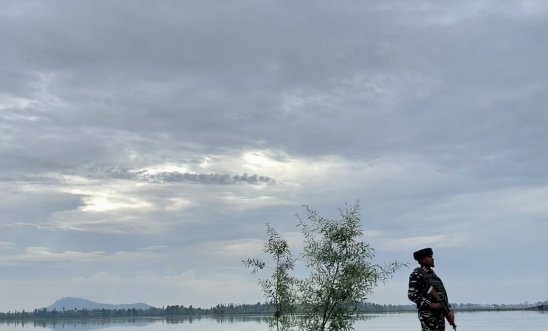
FIVE YEARS OF SILENCE AND STRUGGLE IN KASHMIR

By Ahmad* with Cherry Bird, Country Coordinator for India
It has been five years since India revoked Jammu and Kashmir's semi-autonomous status, a decision that plunged the region into a stringent lockdown marked by extensive control over freedom of the press, expression, and politics. Thousands of activists, human rights defenders, journalists, and political figures found themselves imprisoned, either within Kashmir or in facilities across India. The crackdown has shown no signs of abating, with severe media restrictions in place and pro-government media outlets gaining unprecedented influence.
The 2019 decision has had a particularly devastating impact on local journalism. New media laws have stifled reporting, creating a climate of fear among journalists. Many have been arrested under anti-terror laws like the UAPA, while numerous others have been coerced into self-censorship by authorities. This has led to significant job losses among journalists, forcing many to relocate to other Indian cities. Local newspaper editors have been replaced by state-supported staff, and entire archives have been erased. Civil society and human rights organizations have been rendered nearly inoperative, with prominent human rights activist Khurram Parvez imprisoned for three years.
Simultaneously, political changes have ushered in a wave of Indian investors securing contracts for infrastructure projects in Kashmir, often at the expense of prime agricultural land and apple orchards. These projects, including the expansion of railway operations, threaten the livelihoods of local inhabitants, disturb the region’s delicate ecosystem, and contribute to rising temperatures, glacier melting, and declining water levels.
Kashmir's agricultural sector, a cornerstone of the local economy, is under siege from both political and climate pressures. The average landholding in Jammu and Kashmir is a mere 1.55 acres, significantly smaller than the national average of 2.9 acres. Infrastructure projects and unchecked tourism are reducing agricultural land, straining natural resources, and eroding traditional livelihoods. Farmers are being displaced by the construction of railways and ring roads, forcing them to seek alternative employment. The increased tourism in highland areas disrupts pastoralist communities and exacerbates human-animal conflicts.
These infrastructure projects have potential to displace farming communities, disrupting their way of life, culture, and community bonds. The loss of agricultural land translates to reduced food security and economic instability for over 80% of Kashmir's population, who depend on agriculture. New land laws have facilitated numerous projects, with Indian construction companies investing millions in shopping malls, IT towers, and industrial units, often at the expense of forests and prime agricultural land, as reported by MSN.
Earlier this year, local authorities proposed constructing a 77 km railway line in Shopian, which would require acquiring 278 hectares of fertile land, mainly apple orchards crucial to the local economy, according to Al Jazeera. The broader climate crisis further threatens agricultural productivity with unpredictable weather patterns and changing growing conditions. In 2020, the government acquired 239.27 hectares of prime agricultural land in central Kashmir for a 40 km semi-ring road, despite significant resentment from farmers who were forced to accept inadequate compensation, resulting in substantial livelihood losses, as reported by Greater Kashmir.
The news of peace, development, and stability has remained the core agenda on news channels across India, justifying the decision taken on August 5, 2019. The average Indian is being brainwashed and coerced into believing that peace has been brought to the region, undermining the existing realities. This reality is one of fear and an undeclared emergency. The surge in tourism is often equated with peace, but it masks underlying socio-political and environmental issues. The focus on tourism and infrastructure development overlooks the critical need for sustainable practices that protect the environment and the livelihoods of local communities.
Climate change has exacerbated the situation, bringing erratic weather patterns that cause frequent floods, landslides, and droughts, leading to significant loss of life and property. In July 2024, Indian forces proposed taking 45.42 sq km of forest land in the pristine Gurez Valley, raising serious concerns among local communities about potential environmental devastation.
The surge in tourism has also led to increased waste, pollution, and strain on natural resources, directly impacting agricultural practices. Polluted water sources affect crop irrigation, while the overuse of land for tourism infrastructure compromises soil health. Large-scale infrastructure projects, such as railways and ring roads, encroach upon prime agricultural land, leading to the loss of fertile soil and deforestation, further exacerbating climate issues. The oppressive regime makes it difficult for farmers to protest, as evidenced by the arrest of 50 farmers in February 2024. Forests, which cover 20% of Kashmir, are crucial for ecological balance and soil protection. However, between 2001 and 2012, tree cover in Kashmir decreased by over 4%, according to Mongabay magazine.
Behind the facade of stability lies a region grappling with fear, repression, and environmental degradation. As Kashmir navigates these tumultuous times, it is imperative to keep the conversation on Kashmir going, ensuring that the voices of its people are heard and their struggles acknowledged.
*Name changed for security reasons
Our blogs are written by Amnesty International staff, volunteers and other interested individuals, to encourage debate around human rights issues. They do not necessarily represent the views of Amnesty International.
0 comments